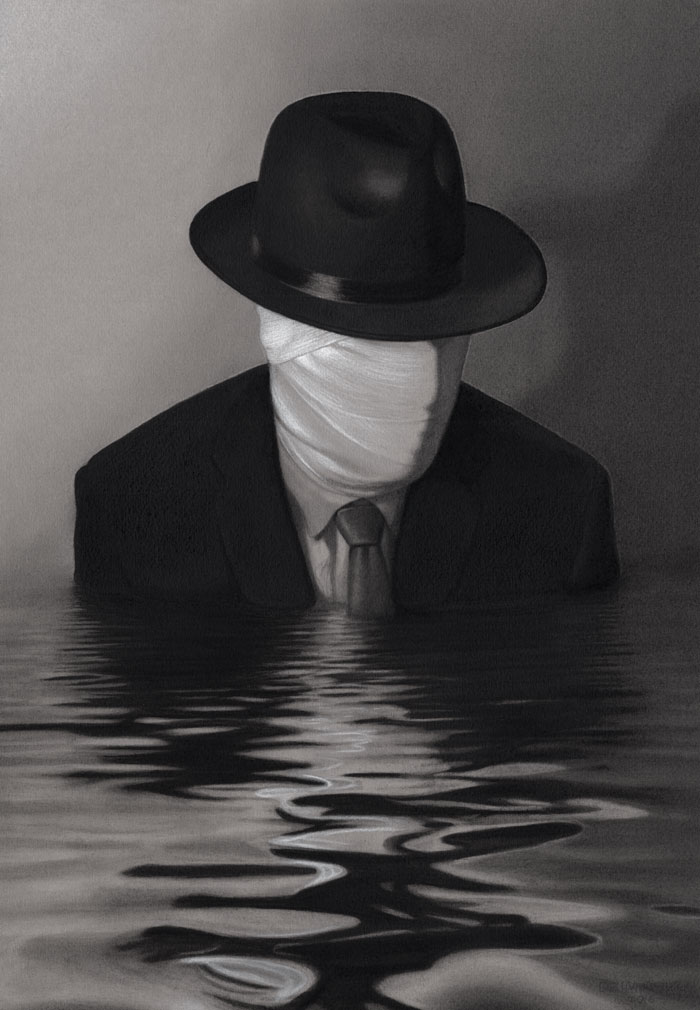
'Drowning' - charcoal on canvas, 2016
Your pieces use incredible skill to create hyperrealist works - is this something you’ve studied for for a long time, and what techniques do you use to create the depth in the pieces that gives them that really engrossing quality?
For the last 12 years I have been a full-time, self taught artist, my first try at hyperrealistic artworks was about 10 years ago. Since then my approach and technique have evolved slowly into what I am doing now. For drawings I work on gray paper using graphite and carbon pencils for the shadows and a white charcoal pencil for the lights. I want to create depth and atmosphere in my drawings. I often hear that my drawings look like photographs but actually I draw in a sculptural approach which differs to the optical approach. I consider my work as sculptures in 2D rather than as hyper- or photorealistic renderings.

'Insomnia' - charcoal on canvas, 2015
The works feature quite a dark atmosphere, you say it's to convey the vulnerability of their condition - why do you think your practise is so centred on showing this?
I think inside we are all very vulnerable, no matter what we show on the outside. We all kinda live in our own world which is so different from the world around us and how people see us. I want to show the inner, often darker and lonely world within us.

' Black Sun' - pencil on paper, 2011
You feature quite a varied range of people in your works, where do you find them?
I find the people for my art everywhere. People I meet through my art, or I see someone in public that I really want to work with, so I ask. Now I also discover models on the internet.

'Umused Truth' - oil on canvas, 2013
Talk us through the process from initial photos to final outcome.
Usually I start with sketches or basic ideas. Once I found matching models for those ideas I arrange a photo shoot. I do all the photo references myself (with some very rare exceptions). The mood of a B/W drawing is so different from a colourful painting. So I normally know upfront what the photos are for and set up the lights for the photo shoot accordingly, but nonetheless I still might use my drawing photo reference for a painting in the end. A drawing usually takes between 1 to 2 weeks but sometimes up to a month. A painting 3 to 6 weeks, depending on the size and complexity.
Conceptually your works are quite striking, for example ‘Valley of Fear’ - how do you come to compositions like this, what kind of questions do you ask yourself during the process?
Most artists that I know, including myself, are not really asking deep questions before or during creating a piece. An idea develops through playing around with certain elements and finding a good composition. After the initial idea, one is mostly concerned about practical aspects of the work such as; composition, color schemes or balancing the light and dark accents, etc. The meaning and the interpretation is then the viewer's job.

' Valley of Fear' - pencils on paper, 2016
Along with you personal pieces, you’ve done a couple of projects! One of which, for the Waterman Pen Company, was featured on massive billboards in Paris and Tokyo - how did that feel, to know hundreds of thousands of people were seeing it?
You create art firstly for your self. But, of course, you want it to be seen. Therefore it is great to be able to reach so many people nowadays. On the other hand people are bombarded with images, advertising and (useless) information constantly, that I guess might make it even harder to really reach them. Those that take the effort and visit a gallery or a museum to see art in person, are the ones that artists are really appreciate.
You also did a series for the TV show ‘The Returned’ which carries your dark feel to it also, is working with TV and film something you’d be interested in doing more of?
A&E Network asked me to do a couple of drawings for the TV show as part of their ad campaign. Often I turn down commercial inquiries because they are artistically uninteresting, but with "The Returned" they wanted my art and I had my artistic freedom. So of course I agreed. I currently have a few people from the movies and music business that model for me for my personal art. This is something I am more interested in rather than being hired for a production. But if the conditions are right I am open for pretty much anything.

'The Returned' - pencil on paper, 2014
TO SEE MORE OF DIRKS’ WORK VISIT www.dzimirsky.com
INTERVIEW by HANNAH SMITH ( Art Jobs )
'Happy Birthday, Tristesse' - Pencils on paper, 2016


